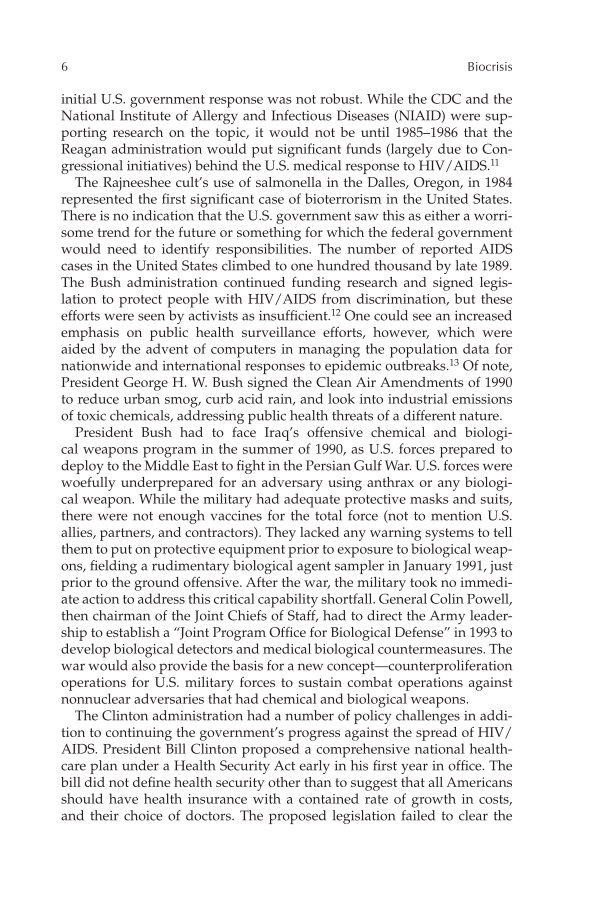6 Biocrisis initial U.S. government response was not robust. While the CDC and the National Institute of Allergy and Infectious Diseases (NIAID) were sup- porting research on the topic, it would not be until 1985–1986 that the Reagan administration would put significant funds (largely due to Con- gressional initiatives) behind the U.S. medical response to HIV/AIDS.11 The Rajneeshee cult’s use of salmonella in the Dalles, Oregon, in 1984 represented the first significant case of bioterrorism in the United States. There is no indication that the U.S. government saw this as either a worri- some trend for the future or something for which the federal government would need to identify responsibilities. The number of reported AIDS cases in the United States climbed to one hundred thousand by late 1989. The Bush administration continued funding research and signed legis- lation to protect people with HIV/AIDS from discrimination, but these efforts were seen by activists as insufficient.12 One could see an increased emphasis on public health surveillance efforts, however, which were aided by the advent of computers in managing the population data for nationwide and international responses to epidemic outbreaks.13 Of note, President George H. W. Bush signed the Clean Air Amendments of 1990 to reduce urban smog, curb acid rain, and look into industrial emissions of toxic chemicals, addressing public health threats of a different nature. President Bush had to face Iraq’s offensive chemical and biologi- cal weapons program in the summer of 1990, as U.S. forces prepared to deploy to the Middle East to fight in the Persian Gulf War. U.S. forces were woefully underprepared for an adversary using anthrax or any biologi- cal weapon. While the military had adequate protective masks and suits, there were not enough vaccines for the total force (not to mention U.S. allies, partners, and contractors). They lacked any warning systems to tell them to put on protective equipment prior to exposure to biological weap- ons, fielding a rudimentary biological agent sampler in January 1991, just prior to the ground offensive. After the war, the military took no immedi- ate action to address this critical capability shortfall. General Colin Powell, then chairman of the Joint Chiefs of Staff, had to direct the Army leader- ship to establish a “Joint Program Office for Biological Defense” in 1993 to develop biological detectors and medical biological countermeasures. The war would also provide the basis for a new concept—counterproliferation operations for U.S. military forces to sustain combat operations against nonnuclear adversaries that had chemical and biological weapons. The Clinton administration had a number of policy challenges in addi- tion to continuing the government’s progress against the spread of HIV/ AIDS. President Bill Clinton proposed a comprehensive national health- care plan under a Health Security Act early in his first year in office. The bill did not define health security other than to suggest that all Americans should have health insurance with a contained rate of growth in costs, and their choice of doctors. The proposed legislation failed to clear the
Document Details My Account Print multiple pages
Print
You have printed 0 times in the last 24 hours.
Your print count will reset on at .
You may print 0 more time(s) before then.
You may print a maximum of 0 pages at a time.



































































































































































































































































































